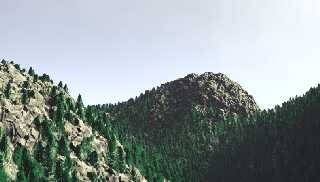 |
 |
|
 |
|
 |
|  |
|  |
|
 |
|
 |
|  |
|  |
|
 |
Hello everyone. Here's an idea built from previous attempts (not all my
own) at making plant and tree life using height fields. I'd like some
feedback if possible (suggestions, tales of personal attempts, etc.).
Two HFs are used in this image: one for the rocks and one for the trees.
The trees use the same topology that was used for the rocks (minus a
feature, plus a feature), with a special angle-dependent texture to
give them fuzzy edges. Manipulation of surface normal accuracy was also
needed for this purpose.
There are many things to improve upon, such as making the trees more
detailed and developing new tree types. I believe the technique has
great potential. What do you think?
-Sam Benge
P.S. Oh yeah, it took very little time to render.... something like
under four minutes if I'm remembering correctly.
Post a reply to this message
Attachments:
Download 'forest.jpg' (77 KB)
Preview of image 'forest.jpg'

|
 |
|  |
|  |
|
 |
|
 |
|  |
|  |
|
 |
Clever! And very interesting :)
cu!
--
ZK AKA Gaeriel
http://www.povplace.be.tf
"I escaped somehow. Let's go!"
Post a reply to this message
|
 |
|  |
|  |
|
 |
|
 |
|  |
|  |
|
 |
The technique certainly has potential. I seem to remember trying something
similar myself a while ago, though I don't think I ever got it looking that
good.
My suggestion would be change the texture on the trees. I'm not sure if it's a
symptom of the "fuzzy edge" technique, but the trees in the foreground really
look wrong. I'd suggest use a more opaque texture (though not totally) with a
high frequency normal to simulate dense foliage.
But, having said that, I don't really think it needs to look good close up, it
seems much better suited to showing sweeping hills covered in thousands of
trees.
Nice work.
--
Tek
www.evilsuperbrain.com
"Samuel Benge" <stb### [at] hotmail com> wrote in message
news:40D### [at] hotmail com> wrote in message
news:40D### [at] hotmail com...
> Hello everyone. Here's an idea built from previous attempts (not all my
> own) at making plant and tree life using height fields. I'd like some
> feedback if possible (suggestions, tales of personal attempts, etc.).
>
> Two HFs are used in this image: one for the rocks and one for the trees.
> The trees use the same topology that was used for the rocks (minus a
> feature, plus a feature), with a special angle-dependent texture to
> give them fuzzy edges. Manipulation of surface normal accuracy was also
> needed for this purpose.
>
> There are many things to improve upon, such as making the trees more
> detailed and developing new tree types. I believe the technique has
> great potential. What do you think?
>
> -Sam Benge
>
> P.S. Oh yeah, it took very little time to render.... something like
> under four minutes if I'm remembering correctly.
>
-------------------------------------------------------------------------------- com...
> Hello everyone. Here's an idea built from previous attempts (not all my
> own) at making plant and tree life using height fields. I'd like some
> feedback if possible (suggestions, tales of personal attempts, etc.).
>
> Two HFs are used in this image: one for the rocks and one for the trees.
> The trees use the same topology that was used for the rocks (minus a
> feature, plus a feature), with a special angle-dependent texture to
> give them fuzzy edges. Manipulation of surface normal accuracy was also
> needed for this purpose.
>
> There are many things to improve upon, such as making the trees more
> detailed and developing new tree types. I believe the technique has
> great potential. What do you think?
>
> -Sam Benge
>
> P.S. Oh yeah, it took very little time to render.... something like
> under four minutes if I'm remembering correctly.
>
--------------------------------------------------------------------------------
Post a reply to this message
|
 |
|  |
|  |
|
 |
|
 |
|  |
|  |
|
 |
"Tek" <tek### [at] evilsuperbrain com> schreef in bericht
news:40d4a3c1$1@news.povray.org...
> The technique certainly has potential. I seem to remember trying something
> similar myself a while ago, though I don't think I ever got it looking
that
> good.
>
The technique is suggested in Leveller (Daylon Graphics) to simulate exactly
this kind of thing. com> schreef in bericht
news:40d4a3c1$1@news.povray.org...
> The technique certainly has potential. I seem to remember trying something
> similar myself a while ago, though I don't think I ever got it looking
that
> good.
>
The technique is suggested in Leveller (Daylon Graphics) to simulate exactly
this kind of thing.
Post a reply to this message
|
 |
|  |
|  |
|
 |
|
 |
|  |
|  |
|
 |
Excellent!
The texture of the trees need a little more work, if you want to use it in
the foreground.
Thomas
Post a reply to this message
|
 |
|  |
|  |
|
 |
|
 |
|  |
|  |
|
 |
High!
Really cool... looks pretty much like those not very dense mountain forests in
Paktia province, Afghanistan... what about a
dirt track winding along the mountainside, with a small camel caravan of
Pashtun timber smugglers? Or perhaps one of those
notorious Taliban/Al-Qa'eda hideaway caves, perhaps featuring even OBL in
persona... and one or two US jet fighters
screaming across the sky!
See you in Khyberspace!
Yadgar
Now playing: I hear you now (Jon Anderson & the SFX Band - a very rare version
of this originally Jon & Vangelis song,
recorded on a benefiz concert for Mencap)
Post a reply to this message
|
 |
|  |
|  |
|
 |
|
 |
|  |




![]()